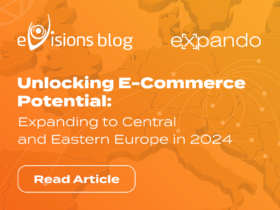Online Expansion to Spain: E-Commerce Guide from A-Z
10. 06. 2024 AutorThis guide offers a deep dive into Spain’s online shopping scene, highlighting its culture, popular payment methods and more… Whether you’re considering expanding your business or simply exploring the market, you’ll learn about how to build credibility for online stores.
Let’s explore what makes Spain’s E-commerce market unique and how you can navigate it with ease!
Content
- Culturally-Rich Spain
- Spanish E-Commerce in Numbers
- Average Spanish Online Customer
- Building Trustful Website
- The Most Common Payment Methods
- Delivery Methods You Cannot Miss
- Key Takeaways
Spanish Culture and E-commerce:
Building Trust and Connection
Interested in the Secrets of the Spanish Market?
Join Our Exclusive Webinar Before Diving into Our In-depth Article!
Spain boasts a rich culture and a rapidly growing e-commerce market. Understanding some key cultural aspects can help you tailor your online store for success in Spain.
First of all, it is important to know that in Spain there are many provinces with their own culture and language:
Here are some examples of websites that use Basque, Catalan, Valencian and Galician.
Basque Country
The Basque Country uses Euskara (Basque) alongside Spanish.
Providing support in both languages can enhance the customer experience.
Catalonia
The Catalan language is widely spoken, and providing customer support in Catalan may improve trust and loyalty.
What is more, Catalans tend to favour local brands and products, so offering local options can attract customers.
Galicia
Galician (Galego) is an official language; supporting it can help reach local customers effectively.
Regarding product preferences, Galicians have an appreciation for quality and local products.
Valencia
Valencian (a dialect of Catalan) is spoken; offering support in this language can improve customer service.
If e-commerce is primarily concentrated in these provinces, It is essential to use their preferred form of the language. Have to note, that Spanish is still spoken in all these provinces but the more a business wants to thrive, the more it needs to focus on the local customs.
We are organizing a webinar focused online expansion to Spain!
Learn more about the webinar by clicking on below:
Immigration in Spain
This country is notably hospitable to immigrants, making it crucial to at least broadly consider their cultural backgrounds. Many of these immigrants are Moroccan (883,243) and Romanian (627,478). When considering the preferences of Moroccan and Romanian immigrants in Spain, there are a few cultural nuances to keep in mind:
Moroccan Preferences:
- Halal Products: Offer a range of halal food products and other goods that adhere to Islamic dietary and lifestyle standards.
- Traditional Apparel and Modest Fashion: Provide clothing options that include traditional Moroccan attire and modest fashion that aligns with cultural and religious preferences.
- Family-Oriented Products: Focus on family-sized products, especially in categories such as food, home goods, and children’s products.
Romanian Preferences:
- Traditional Romanian Products: Include Romanian food and drink options such as sarmale, mici, and other favourites. Additionally, offer Romanian cultural items like music and books.
- Connection to Romania: Offer services or promotions tied to Romanian holidays and traditions, such as special sales during Romanian festivals or holidays.
- Community-Oriented Marketing: Use targeted marketing campaigns focusing on the Romanian community’s interests, including events, news, and promotions.
These customers from Romania and Morocco opt for the same payment method: Offer preferred payment methods and shipping options that appeal to these customers, such as cash on delivery or mobile payment methods.
Acknowledging and integrating these cultural differences can significantly improve your e-commerce strategy across Spain’s diverse regions.
Building Trust is Vital
Spanish consumers, similarly to Hungarians, tend to be cautious online shoppers.
Therefore, building trust is crucial and here are a few tips on how to achieve it:
- Spanish Website: Ensure your website is completely in Spanish (or in the dialect of the region). This involves more than merely translating content. It is about localisation, adapting the tone and style to truly resonate with the local audience. A native speaker should feel that the business comes from Spain, not from abroad.
- Secure Transactions: Highlight secure payment methods like PayPal, widely preferred by Spanish consumers.
- Customer Reviews: Showcase positive customer reviews to build confidence in your brand. There are a lot of review portals in Spain, but the most used are, Confianza Online and Trust Profile. We will talk more about this topic below in the section on building trustful websites.
Localization Matters
Compared to Poles, who have a strong preference for domestic products, Spanish consumers are more receptive to international brands. Nevertheless, localization is still crucial.
- Cultural Sensitivity: Avoid humour or imagery that might be misinterpreted in Spain. When operating in the Spanish market, it’s important to be aware of cultural nuances to avoid offending potential customers. This includes understanding the country’s history, traditions, and customs, as well as avoiding stereotypes or culturally insensitive jokes and imagery.
For example, avoid using images or jokes that might perpetuate stereotypes about Spanish culture, such as oversimplified images of bullfighting or flamenco dancing, unless they are contextually relevant and respectful. Also, be cautious with humour, as what might be funny in one culture can easily be misinterpreted in another.
- Mobile Optimization: Ensure your website is mobile-friendly, as many Spaniards use smartphones for online shopping. More than 59% of the share of online purchases in 2023 have been done through mobile phones.
Embrace Local Preferences
- Deliver Speed and Value: Spanish online shoppers prefer free shipping over fast shipping. Up to 90% of online consumers prioritise free deliveries over getting the package at home or very quickly. Also, 30% would rather pick up the order at a delivery point if this saves money. This indicates that offering free and convenient delivery options can incentivize purchases.
- Easy Returns and Address Concerns with Transparency: Most online consumers in Spain (7 out of 10) make returns on a regular basis, although these returns represent fewer than 10% of their purchases. Also, 21% of digital buyers are willing to pay for returns, but never more than 10% of the original value of the product. Providing a clear and easily accessible return policy on your website can build trust and encourage purchases.
In addition, the e-commerce market in Spain is growing. Nearly 59% of customers said they had increased their online shopping in the last 12 months. Also, e-commerce spending constituted nearly 6% of the country’s GDP in 2022, ranking among the highest in Europe. This suggests a promising future for e-commerce in Spain.
Spanish e-commerce in numbers
Spain’s e-commerce landscape is characterised by a significant and rapidly growing market, driven by a population of approximately 47.5 million people. The country presents a vast potential customer base for e-commerce businesses, with 80% of the population actively participating in online shopping. This high level of engagement is supported by an internet usage rate of 89.59%.
Online sales currently account for 59,4% of the total retail market in Spain, reflecting steady growth as consumers increasingly embrace the convenience of online shopping. The total turnover in Spain’s e-commerce sector is around €25.5 billion with the number of E-shops being 135.000, underscoring the sector’s size and strength.
“The rapid expansion of e-commerce in Spain is evident in its 29% year-over-year growth, demonstrating the rising preference for online shopping among Spanish consumers.”
When it comes to devices used for online purchases, desktops remain the preferred choice, making up 78% of purchases, while mobile devices account for 59%. These trends shape the shopping experience for consumers across the country.
Spain’s e-commerce market is a vibrant and diverse ecosystem, featuring a mix of both international and local brands. Leading the pack is Amazon, with its vast product range and competitive pricing. Following closely are El Corte Inglés and Carrefour, both of which have a strong presence in the country.
Online marketplaces are incredibly popular in Spain. In fact, more than two-thirds of Spaniards purchased physical goods online in 2022. Amazon is the most popular online marketplace, with nine out of ten online shoppers using the platform. Other marketplaces such as AliExpress, El Corte Inglés, and Decathlon also enjoy significant popularity. These platforms offer a wide variety of products, making them a preferred choice for many consumers over individual e-shops.
Favourite product categories
In terms of product categories, seven markets are considered within the Spanish eCommerce market. Electronics is the largest market and accounts for 25.1% of the Spanish eCommerce revenue. It is followed by Hobby & Leisure at 21.1%, Fashion at 16.4%, Care Products at 10.6%, Furniture & Homeware at 10.3%, Grocery at 8.5%, and DIY with the remaining 7.9% These categories dominate the online shopping landscape, reflecting the consumer preferences and shopping habits in the country.
Several global brands have also successfully established their presence in Spain. Brands like Leroy Merlin, H&M, Vodafone, Samsung, and Heineken have managed to gain a significant market share, build strong brand awareness, and generate substantial revenue in the online marketplace. The term ‘successfully established’ in this context refers to these achievements. For instance, Amazon’s success in Spain can be attributed not just to its early revenue or high brand awareness, but also to its wide range of products and services, competitive prices, and the convenience it offers to customers.
In conclusion, Spain’s e-commerce market is thriving and competitive, with high levels of participation and spending among the population. The variety of online retailers and successful expansions of global brands create a dynamic and vibrant online shopping environment. Businesses have the opportunity to tap into this expanding market and cater to the evolving preferences of Spanish consumers. In the vibrant digital landscape of Spain, a staggering 135,000 e-commerce platforms are thriving. These online marketplaces have captivated the attention of 35 million individuals, a significant proportion of Spain’s 47 million residents, who have embraced the convenience and variety of online shopping. This robust e-commerce ecosystem is a testament to Spain’s progressive adaptation to the digital age.
Want to learn more about e-commerce in Spain?
Don’t miss our webinar.
Building Trustful Website
As previously mentioned in the culture of Spain about building trust, here it is explained in full how to gain trust from our clients. Building trust in Spanish websites is essential for fostering a positive relationship with customers and ensuring their loyalty. Here are some important factors to consider:
- Local Contact Information: Providing a Spanish phone number and contact email address is crucial. This local touch helps customers feel more comfortable and confident when reaching out for support or inquiries, this is why localization is important.
- Fast Response Times: Spanish customers expect timely responses to their questions or concerns. A quick reply can significantly improve their perception of your service and increase their trust in your business.
- Clear and Transparent Information: Ensure that all information on your website, including terms and conditions, privacy policies, and return policies, is clearly stated and easily accessible. Transparency builds trust and helps customers feel secure when making transactions.
- Confianza Online: This is a well-known trust portal in Spain that certifies websites for their quality and ethical practices. By displaying the Confianza Online seal on your website, you can assure customers that your business meets high online safety and consumer protection standards. They also offer the seal of real opinions in collaboration with eKomi, to enhance the reputation of online stores. Displaying customer reviews and testimonials can provide social proof and enhance credibility. Positive feedback from other customers reassures new visitors about the quality of your products or services.
- Secure Payment Options: Offering secure and popular payment options such as credit cards, digital wallets, and trusted third-party payment processors helps build trust. Customers want to know their financial information is safe.
- User-Friendly Experience: An easy-to-navigate website with clear, concise information and intuitive design can boost customer confidence and trust.
By focusing on these aspects, you can create a trustworthy online presence that will help you build and maintain strong relationships with Spanish customers.
Most Common Payment Methods
In Spain, the payment landscape is evolving rapidly as digital technology and convenience increasingly shape the way people handle their transactions. Here are the most common payment methods used in Spain:
- Credit and Debit Cards: Cards remain the most popular payment method, accounting for over half of all transactions. This method is favoured for its ease of use and acceptance across a wide range of retailers, both in physical stores and online.
- Digital Wallets: Digital wallets are becoming increasingly popular in Spain, with 25% of transactions being completed using this method. Services such as Apple Pay, Google Pay, and other digital wallets offer convenience and security for consumers, allowing them to make payments with just a few taps on their smartphones.
- Cash: While cash is still used for some transactions, its popularity has significantly declined in recent years. Only 3% of transactions in Spain are completed using cash, reflecting a broader global trend towards digital payments.
- Bank Transfers: Bank transfers account for a moderate percentage of transactions in Spain. This method is often used for larger purchases or when dealing with invoices and recurring payments. It’s known for being secure and efficient, especially for business transactions.
- Buy Now, Pay Late: The Buy Now, Pay Later (BNPL) option is gaining traction in Spain, with 8% of transactions being conducted through this method. BNPL services offer consumers the ability to purchase goods and pay for them in instalments, making it an attractive option for those looking for flexible payment plans.
As Spain continues to embrace digitalization, it’s expected that the use of digital wallets and other innovative payment methods will continue to rise. This shift toward modern, convenient payment methods reflects the changing preferences and habits of Spanish consumers.
Delivery Methods
Spain hosts a variety of parcel delivery companies too, that cater to different needs. These include well-known international companies like DHL, FedEx, and UPS, as well as local companies like Correos, SEUR, and MRW. These companies offer a range of services from standard shipping to more specialised options like temperature-controlled deliveries for perishable goods.
Here are top methods of delivery in Spain:
- Home Delivery: This is the most common delivery preference among Spanish consumers. Many opt for home delivery due to its convenience, allowing them to receive packages directly at their homes. Brands like El Corte Inglés and Amazon have optimised this method, offering real-time tracking and same-day delivery services in specific areas.. But there are more delivery methods that can be used in Spain.
- Pickup Points and Lockers: Pickup points and lockers provide alternative delivery options, offering flexibility for consumers to collect their packages at their convenience.
- Express and Same-Day Delivery: There is a growing demand for faster delivery options, with consumers willing to pay extra for expedited shipping, particularly for urgent or time-sensitive items. 25% of home delivery are express and same-day delivery.
- Green and Sustainable Delivery: Eco-friendly delivery options are gaining traction, reflecting the increasing environmental awareness among Spanish consumers. 64% of all the deliveries are green and sustainable delivery.
Conclusion
In conclusion, Spain’s e-commerce market presents a dynamic landscape full of opportunities for businesses looking to expand their online presence. By understanding regional cultural nuances in the Basque Country, Catalonia, Galicia, and Valencia, you can tailor your approach to meet the unique preferences of each area.
Building trust through local language support, secure payment options, and fast, reliable customer service is essential to succeed in this market. Additionally, offering multiple payment methods, including credit and debit cards, digital wallets, and Buy Now, Pay Later services, ensures that you cater to the diverse needs of Spanish consumers.
Delivery methods such as home delivery, pickup points, and express services should also align with customer preferences to create a seamless shopping experience.
Embracing local tastes and offering a personalised approach can set your business apart and establish lasting connections with Spanish customers. As Spain’s online market continues to grow, strategic adaptation and localization will be key to thriving in this vibrant e-commerce landscape.










![Achieving 276% y-o-y Blog Traffic Growth with Topical Authority [Case Study]](https://www.evisions-advertising.com/yPVTOLUdUV/uploads//2024/08/e-blog__EN-1-280x210.png)

Komentáře